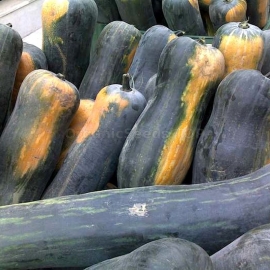



«Lunga di Napoli» - Organic Pumpkin Seeds
1.14 €
Lunga di Napoli squash have a large, oblong shape with a slightly bulbous end that includes the squash’s seed cavity. Its exterior skin ripens from yellow to dark green, with orange or light green striations.
-
Italian heirloom pumpkin «Lunga di Napoli»
Lunga di Napoli squash have a large, oblong shape with a slightly bulbous end that includes the squash’s seed cavity. Its exterior skin ripens from yellow to dark green, with orange or light green striations.
The inner flesh is a deep, vibrant orange and surrounds a small, stringy seed cavity. The cooked flesh of the Lunga di Napoli is smooth and dry offering a mild, slightly sweet squash flavor. Lunga di Napoli are most often compared to the butternut squash, although this squash tends to be larger in size than a butternut and can weigh on average between twenty and thirty-five pounds when fully mature.
Lunga di Napoli squash has long been a common squash in Italy and the Mediterranean region. Mention of it can be found dating back to 1856 in Vilmorin’s classic illustrated album of French garden vegetables. The Lunga di Napoli squash is believed to have first appeared in an American seed catalog in 1863 listed by Fearing Burr.
Though it has never caught on as a commercially viable squash variety in the United States, it has found popularity among home growers and competitive growers as a result of its ability to grow to massive sizes. Lunga di Napoli squash thrives in warm growing conditions and should be planted after the last frost has passed in the spring and harvested before the first frost of the fall or winter. Typically squash are ready for harvest within one hundred days of planting.
How to grow
Timing
Direct sow or transplant in late May or early June when soil warms up. For transplants, start seeds indoors during the first two weeks of May. Make sure plants go into the ground no later than June 15th. Optimal soil temperature for germination: 25-35°C (68-95°F). Seeds should sprout in 7-14 days.
Starting
Sow seeds 2cm (1″) deep. Sow 3 seeds in each spot you want a plant to grow and thin to the strongest plant. Space plants at a minimum of 90-120cm (36-48″) apart in rows 120-180cm (48-72″) apart. If starting transplants indoors, consider using the 12-cell plug inserts.
Growing
Ideal pH: 6.0-6.8. These big plants need lots of food! Choose a sunny spot with fertile, well-draining soil. Dig in a generous quantity of finished compost and/or composted manure. Dig in 1 cup of complete organic fertilizer under each plant. All pumpkins grow male flowers first, then the female flowers are produced. The female flowers have tiny fruits at the base of the petals and require pollination by bees, mostly. Incomplete pollination is common at the beginning of the season, and results in small fruits that are misshapen at the flower end. Discard these damaged fruits before they rot.
For the largest pumpkins, feed weekly throughout the growing season with fish or kelp based fertilizer. Keep the huge plants well watered, particularly in hot weather. Always water the soil, and avoid any form of overhead watering other than rain. Fruit will grow larger if you keep only one fruit per vine. As the fruit develops, try to gently encourage it to grow at a 90° angle to the vine itself. The largest pumpkin varieties will grow on their sides.
Harvest
Like other winter squash, pumpkins are mature when they have coloured up well and their stems are crisp. For the best sugar content, cut the stem about 4cm (2″) or so from the body of the fruit. If the weather is dry, allow the pumpkins to cure in the field for 10 days, or in a warm room for 4-5 days. Bring pumpkins in under cover before rain.
